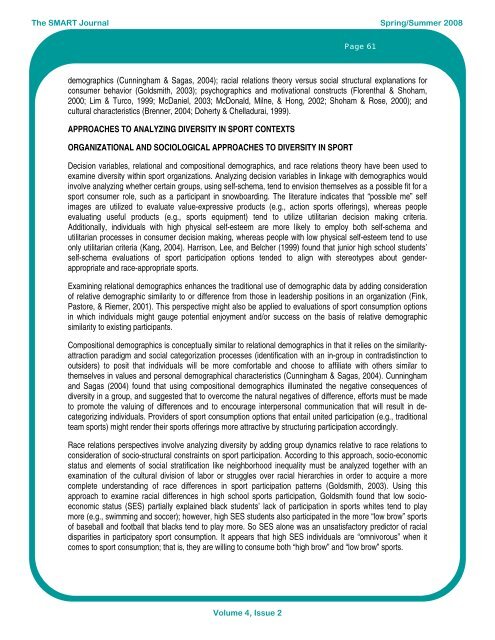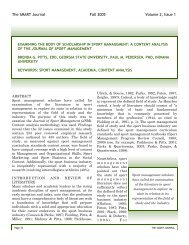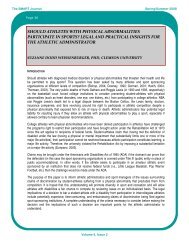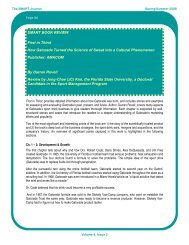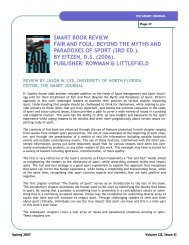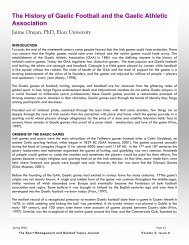Spring/Summer 2008 Volume 4, Issue 2 - The SMART Journal
Spring/Summer 2008 Volume 4, Issue 2 - The SMART Journal
Spring/Summer 2008 Volume 4, Issue 2 - The SMART Journal
Create successful ePaper yourself
Turn your PDF publications into a flip-book with our unique Google optimized e-Paper software.
<strong>The</strong> <strong>SMART</strong> <strong>Journal</strong> <strong>Spring</strong>/<strong>Summer</strong> <strong>2008</strong><br />
Page 61<br />
demographics (Cunningham & Sagas, 2004); racial relations theory versus social structural explanations for<br />
consumer behavior (Goldsmith, 2003); psychographics and motivational constructs (Florenthal & Shoham,<br />
2000; Lim & Turco, 1999; McDaniel, 2003; McDonald, Milne, & Hong, 2002; Shoham & Rose, 2000); and<br />
cultural characteristics (Brenner, 2004; Doherty & Chelladurai, 1999).<br />
APPROACHES TO ANALYZING DIVERSITY IN SPORT CONTEXTS<br />
ORGANIZATIONAL AND SOCIOLOGICAL APPROACHES TO DIVERSITY IN SPORT<br />
Decision variables, relational and compositional demographics, and race relations theory have been used to<br />
examine diversity within sport organizations. Analyzing decision variables in linkage with demographics would<br />
involve analyzing whether certain groups, using self-schema, tend to envision themselves as a possible fit for a<br />
sport consumer role, such as a participant in snowboarding. <strong>The</strong> literature indicates that “possible me” self<br />
images are utilized to evaluate value-expressive products (e.g., action sports offerings), whereas people<br />
evaluating useful products (e.g., sports equipment) tend to utilize utilitarian decision making criteria.<br />
Additionally, individuals with high physical self-esteem are more likely to employ both self-schema and<br />
utilitarian processes in consumer decision making, whereas people with low physical self-esteem tend to use<br />
only utilitarian criteria (Kang, 2004). Harrison, Lee, and Belcher (1999) found that junior high school students’<br />
self-schema evaluations of sport participation options tended to align with stereotypes about genderappropriate<br />
and race-appropriate sports.<br />
Examining relational demographics enhances the traditional use of demographic data by adding consideration<br />
of relative demographic similarity to or difference from those in leadership positions in an organization (Fink,<br />
Pastore, & Riemer, 2001). This perspective might also be applied to evaluations of sport consumption options<br />
in which individuals might gauge potential enjoyment and/or success on the basis of relative demographic<br />
similarity to existing participants.<br />
Compositional demographics is conceptually similar to relational demographics in that it relies on the similarityattraction<br />
paradigm and social categorization processes (identification with an in-group in contradistinction to<br />
outsiders) to posit that individuals will be more comfortable and choose to affiliate with others similar to<br />
themselves in values and personal demographical characteristics (Cunningham & Sagas, 2004). Cunningham<br />
and Sagas (2004) found that using compositional demographics illuminated the negative consequences of<br />
diversity in a group, and suggested that to overcome the natural negatives of difference, efforts must be made<br />
to promote the valuing of differences and to encourage interpersonal communication that will result in decategorizing<br />
individuals. Providers of sport consumption options that entail united participation (e.g., traditional<br />
team sports) might render their sports offerings more attractive by structuring participation accordingly.<br />
Race relations perspectives involve analyzing diversity by adding group dynamics relative to race relations to<br />
consideration of socio-structural constraints on sport participation. According to this approach, socio-economic<br />
status and elements of social stratification like neighborhood inequality must be analyzed together with an<br />
examination of the cultural division of labor or struggles over racial hierarchies in order to acquire a more<br />
complete understanding of race differences in sport participation patterns (Goldsmith, 2003). Using this<br />
approach to examine racial differences in high school sports participation, Goldsmith found that low socioeconomic<br />
status (SES) partially explained black students’ lack of participation in sports whites tend to play<br />
more (e.g., swimming and soccer); however, high SES students also participated in the more “low brow” sports<br />
of baseball and football that blacks tend to play more. So SES alone was an unsatisfactory predictor of racial<br />
disparities in participatory sport consumption. It appears that high SES individuals are “omnivorous” when it<br />
comes to sport consumption; that is, they are willing to consume both “high brow” and “low brow” sports.<br />
<strong>Volume</strong> 4, <strong>Issue</strong> 2


